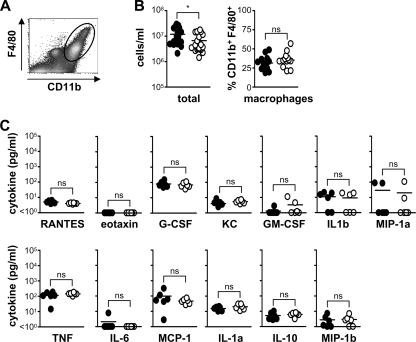FIG. 4.
C3 deficiency does not affect late inflammatory responses to C. albicans. C3−/− and wild-type mice were infected i.p. with 1 × 106 CFU of C. albicans, and inflammatory responses were measured at day 4. (A) Representative flow cytometric profile showing the gate used (25) to identify recruited macrophages. C3 deficiency does not affect cellular recruitment (B) or inflammatory cytokine production (C) following i.p. administration of C. albicans. Values for the wild type versus C3−/− are as follows: 1.18 × 107 ± 1.97 × 106 versus 6.65 × 106 ± 1.20 × 106 total cells/ml. Values for the wild type are as follows: RANTES, 5.0 ± 0.4 pg/ml; G-CSF, 80 ± 16 pg/ml; KC, 4.1 ± 1.1 pg/ml; granulocyte-macrophage CSF (GM-CSF), 1.3 ± 0.3 pg/ml; IL-1β (IL-1b), 10.9 ± 3.5 pg/ml; macrophage inhibitory protein 1α (MIP-1a), 29.5 ± 18.0 pg/ml; tumor necrosis factor (TNF), 115 ± 25 pg/ml; IL-6, 2.1 ± 1.1 pg/ml; monocyte chemoattractant protein 1 (MCP-1), 98 ± 46 pg/ml; IL-1α (IL-1a), 15.7 ± 1.8 pg/ml; IL-10, 5.3 ± 1.2 pg/ml; and macrophage inhibitory protein 1β (MIP-1b), 2.8 ± 1.0 pg/ml. *, P < 0.05 (n > 6 animals per group per experiment). The data shown in panel B are pooled from three independent experiments. Bars indicate mean values of the data.

